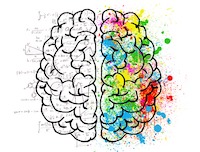In a training, the goal is to have people learn. That should be obvious and yet we frequently see sessions where people walk out, having been entertained, but not having learned anything.
What are the keys for learning:
- People must have come to some new understanding. This could be a new piece of information or a different way of looking at information they already had.
- They must be able to store that new understanding in long term memory.
I’m going to talk about them in reverse order. Storing the learning first and then how we get the learning.
I’m going to illustrate these concepts with a LEGO exercise that I use to teach the concept of Technical Debt. If you’re not a programmer then technical debt is effectively all those things that are working but that are implemented in a way that just slows us down. There is more to it but that’s a good enough explanation for now.

Short term vs long term memory
Having just said that, some of you will now remember what technical debt and some of you will immediately forget as soon as you focus on something else, and that’s exactly the point. For a brief moment, the definition of technical debt was in your working memory and you could immediately access it and use that information to make decisions.
Your working memory has a very limited capacity however, and has to let go of older information as soon as something else comes along.
If someone tapped you on the shoulder right now and asked you a question then your working memory would have cleared to make room for the new question. So when you come back here, it’s likely that you would have lost access to whatever had been in working memory and you’d have to go back a couple of paragraphs to relearn what technical debt was all about.
How much capacity does our working memory have? The research says 5-9 chunks is typical, often described as 7±2.
As new information comes in, something else gets pushed out of working memory to make room. In fact, if we’re startled our brain triggers an electrical spike that clears all of working memory at once.
The key is that if we haven’t already saved that information to long term memory, when working memory gets cleared then it’s gone. And working memory gets cleared frequently.
Note that I’m really oversimplifying memory here. There are many different types of long term memory and information gets stored in many different places in the brain based on a whole slew of factors. The line I’m drawing is between the very fast (electrical) working memory vs the slower (chemical) long term memory.
If information doesn’t get pushed to long term memory, regardless of which kind of long term memory we’re talking about, then there was no learning.
So the question we should be wondering now is how do we force that information into long term memory?
There are two key parts that we’re going to dive into.
- The problem can’t be too cognitively complex.
- We need a dopamine hit to fixate our attention long enough for storage to happen.
Cognitive complexity
Undoubtedly, you’ve heard the term cognitive load to describe how hard we have to think to solve a problem. This can be measured by watching oxygenated blood flow through the brain, and the book “Programmers Brain” describes a number of experiments with software developers that did exactly this.
There are three types of cognitive load and they’re all relevant for our example with technical debt in LEGO.
- Intrinsic load: How complex the problem is in itself
- Extraneous load: What outside distractions add to the problem
- Germane load: Cognitive load create by having to store your thoughts to long term memory
First up is the intrinsic load, which is the complexity of the problem itself. Technical debt isn’t conceptually a difficult idea, although it does run counter to the assumptions we normally make. So the intrinsic load is already fairly low, whether I taught this in code or in LEGO. I am going to establish some rules around the exercise and that will add some more complexity, but it’s not really significant.
Then we have extraneous load which is all the complexity surrounding the problem. In the case of teaching the concept in code, our extraneous load includes the complexity of the programming language itself, the particular code samples that I’ve provided, perhaps the development environment that we’re working within. To teach this with a programming example, there is a quite a bit of extraneous load before we’ve even gotten to the concept I’m trying to teach.
Contrast that with using LEGO. For anyone who played with LEGO as a child, the complexity of the bricks themselves is trivial. We all know how the bricks work and what we can do with them. This is probably the least cognitively tasking thing in the entire exercise.
When we get to the point that we have the learning, the germane load is the effort that it will take to push that learning back into long term memory. How much capacity we have here, will be completely dependent on how much we already used in intrinsic and extraneous load. In the case of the code, it’s quite likely that we’ll solve the problem but not have enough capacity to save it and therefore we will forget how we solved the problem. If that happens then there is no learning.
To recap, by using LEGO, we significantly lowered the extraneous load, without impacting either the intrinsic or germane loads. While there are never any guarantees, we have increased the chance that the lessons will be learned.
Dopamine
The next thing that is required to save something to long term memory is a dopamine hit, to fixate our attention long enough for the process to finish.
The three easiest ways to trigger a dopamine hit are smiling, laughing, and novelty. It’s rare that people aren’t smiling when they’re working with LEGO and it’s usually not hard to set the conditions where they’ll laugh. Novelty we get for free when applying a childhood toy to a business problem.
Although that might make it sound as if we get dopamine completely for free, the key is that they need the dopamine hit at exactly that moment that they’re focused on the learning. Still not really hard with LEGO but it does require a bit of planning.
A common mistake that people make when introducing fun activities into the learning is that they do the fun stuff at a point that the learning isn’t happening. Let’s play a game first and then later we’ll look at the things we need to learn. To maximize learning, the dopamine hit must happen while we’re focused on the learning itself.
Prediction errors
If I just tell you a fact, there’s a chance that you’ll remember it. There’s a significantly greater chance that you’ll remember that same fact if you figure it out on your own though. That’s the magic of prediction errors.
Our brains have evolved into astounding prediction engines. It turns out that to survive, it wasn’t enough to be able to react to a danger, we had to be able to anticipate it. So all animals, are able to predict what’s about to happen, to some degree.
When our brain makes a prediction, there are three possible things that can happen.
- Things happened as predicted. If our brain thinks this was a success then we may get a little dopamine. The catch is that if our brain thinks this was too easy a prediction, it won’t reward us at all.
- Things did not happen as predicted. This is a negative prediction error and results in a drop in dopamine that we interpret as disappointment.
- Things happened unexpectedly better than we predicted. Perhaps I found a clever way to solve the puzzle and am very happy with the result. This is a positive prediction error and results in an increase in dopamine. Laughter is often a positive prediction error.
Learning in general, comes from a prediction error. We either had a drop in dopamine and we immediately adjust our behaviour to fix that or we got an increase in dopamine, fixating our attention and allowing that information to be pushed to long term memory.
When we look back at the LEGO exercise, within five minutes I’m going to walk the participants into a trap. Perhaps they’ll find a clever way to get around the trap (positive prediction error), or perhaps they’ll be disappointed that I trapped them despite their best efforts (negative prediction error). Either way, there’s a good chance that they’ll laugh (dopamine hit) because they’re having fun. The moment of the trap is when it becomes obvious what I’ve done to them and where the problem was. Just as they’re having that realization, we’re triggering dopamine and pushing that understanding into long term memory.
Resource state therapy (aka ego-state therapy)
Resource state therapy says that a healthy adult has about a 150 different resource states (ie personalities), most of which were formed in childhood. On a typical day, we’ll cycle through 10-15 of these.
The resource state that I’m using as I type this is very different from the resource state that I’m using when I’m playing with my cat.
Only one resource state can be active (“in the executive”) at a time although for a healthy person, all the commonly used resource states share information. Each one will bring it’s own perspective, it’s own approach, and sometimes it’s own skills.
Switching between resource states happens automatically and can be triggered by environmental conditions. Something that we experience in the environment that causes one or another resource to enter the executive.
It turns out that our most powerful learning states are our playful states, and almost anything that brings up childhood memories can bring those playful states to the executive. Like, for example, seeing or touching the LEGO bricks that you played with as a child.
This isn’t limited to LEGO by any means. I frequently trigger playful resource states by using funny paperclips (shaped like dogs or cats) or putting pipe cleaners on the table. Anything that brings the participants back into their childhood.
Pyschological Safety
If the thing we want them to learn requires high level, logical, thinking then they must have access to their prefrontal cortex and that means that they must feel safe. See psychological safety and polyvagal theory for the neuroscience there.
Our playful resource states also have an advantage here, as they tend to feel safer even when there is some risk. They activate both the green (safety) and yellow (mobility) responses from Polyvagal Theory in a way that is positive and productive.
With a LEGO exercise in particular, there is intrinsically less risk as mistakes have little consequence and little judgement from others.
Wrap up
I certainly could have taught the same lessons in code, and in the past I probably would have. The trick is that by making it playful, I’ve not only shortened the time it takes to get to the lesson, I’ve made it far more likely that it will stick.
I have a variety of LEGO exercises to teach programming concepts and I use these when teaching in-person. A description of how to facilitate them can be found here, and I encourage you to try them with your groups.
I also use LEGO Serious Play to run retrospectives or to build team working agreements or to do strategic planning.
The key is that while using LEGO in this way is fun, fun is not the goal. The goal is to get better learning and better thinking, and playful approaches help with that.

